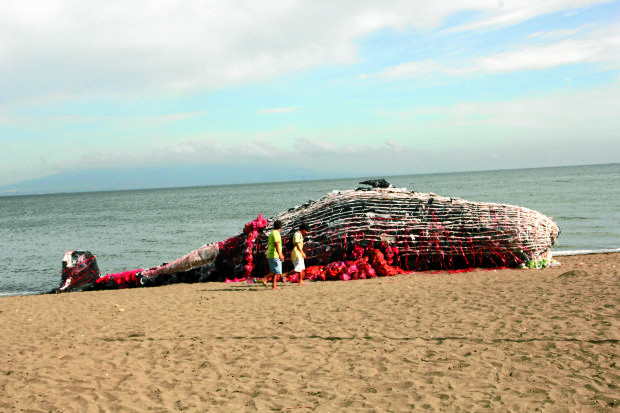Dead whale fake but plastic pollution killing the sea real, says Greenpeace

Residents of Naic, Cavite woke up to this sight of a dead whale which turned out to be an art installation put up to raise awareness on pollution caused by plastics worldwide. —LYN RILLON
A seaside community in Naic town, Cavite province woke up to the grim sight of a 15-meter-long whale lying dead on the shore with its guts spilling out.
“Is that real? Because if it is, it should be stinking so bad by now?” a resident said. Another beachgoer drew nearer and heaved a sigh of relief after closer inspection.
Environmental campaigners took note of how the community reacted as they unveiled the dead whale, actually an installation art, on Wednesday.
They launched it in time for the meeting of the Association of Southeast Asian Nations (Asean) Working Group on Coastal and Marine Environment being held in Manila.
The whale had been scheduled to remain on the beach until tomorrow.
Article continues after this advertisementGreenpeace Oceans campaigner Vince Cinches, on Friday, said the group did not issue an advisory but relied on people to take photos and make the “dead whale” viral on social media.
Article continues after this advertisementPlastic wastes
Greenpeace, with global creative agency Dentsu Jayme Syfu, worked quietly on the installation for five days in another resort.
The 15-meter-long, 3-meter-wide installation was made of bamboo frame stuffed with tons of plastic wastes. It closely resembles a humpback species.
Cinches said they collected discarded plastic from junk shops around Naic and from the town’s materials recovery facility.
The installation simulates what happens to a beached whale, Cinches said.
“A dead whale decomposes from the inside. Over a few days, its body starts to produce methane that pushes out its innards,” he said.
“That’s why scientists doing the necropsy are very careful because [the body] tends to explode,” he said.
Greenpeace said more than 30 sperm whales were washed up on the shores of Europe during the first quarter of 2016 alone.
Cinches said one was found on Samal Island in Davao del Norte province last year and another in Donsol town in Sorsogon province which had been found to have a fishing net inside its stomach.
Realistic
Baleen whales, for instance, are filter feeders and therefore “have no capacity to distinguish food from plastic,” said Cinches.
“There have been a lot of installations made out of trash but none had been this realistic,” said Dentsu creative director Biboy Royong.
Cinches said Greenpeace chose the whale as the best representation of the “mega fauna” to promote marine conservation.
He said the group was urging not only the public to reduce the use of plastic, but also policymakers and the business sector to develop mechanisms, such as buying back plastic packaging, to reduce wastes in the ocean.
Greenpeace said the Philippines ranked third globally as the biggest contributor of plastic wastes in the ocean. Others on this list are Vietnam, Malaysia, Thailand and Indonesia.
“This only demonstrates that every waste ends up in the ocean. As host country [of this year’s Asean Summit], we have the moral obligation to lead the drafting of a clear program that addresses plastic pollution,” he said.